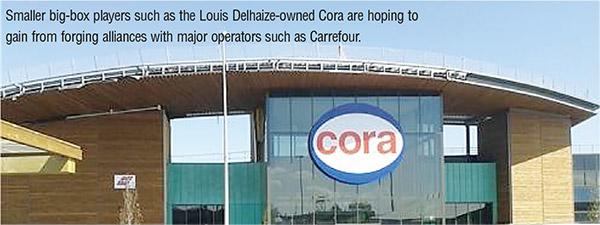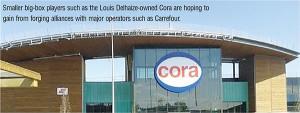Without doubt, 2015 has been a year of struggle for major western European grocery retailers. Falling food price inflation has had a dampening effect on many players’ top-line numbers – with the notable exception of the German discounters, which are rapidly asserting dominance over the upper reaches of the grocery ranking.
A lead now firmly established
Schwarz Group came close to being western Europe’s largest grocer in 2014, and this year the company firmly secured the leadership slot. With sales now more than €2 billion ($2.9 billion) ahead of closest rival Carrefour, the German company’s lead is set to grow to an estimated €8 billion ($11.7 billion) over the second- largest player by 2019.
Though it also owns the Kaufland hypermarket chain, Schwarz Group’s success can chiefly be attributed to its Lidl discount operation, which has been going from strength to strength across the European continent.
A move away from the banner’s discount roots towards acting more like a mainstream supermarket has underpinned its resounding success.
This is best evidenced by the addition of more fresh food, in-store bakeries, branded items and wider premium- private-label assortments. Although many Lidl shoppers still tend to top up elsewhere, the fascia is moving closer to offering a one-stop shop.
Buying alliances come to the fore
In such a tough climate and with mainstream retailers facing heavy competition, it was no surprise that 2014/15 was the year of the buying alliance. This was particularly prevalent in France, where we saw major players such as Carrefour team up with Cora, adding to the roster of existing buying agreements between the likes of ITM (Intermarché) and Casino, plus Auchan and Système U.
Alliances are also increasingly being forged beyond France. Auchan teamed up with Metro Group in a potentially powerful union, while Leclerc reunited with Rewe Group. Elsewhere, we saw collaborations develop in Portugal (Intermarché and Dia), Spain (Eroski and Dia) and, though not a buying alliance per se, the year also brought the merger of Netherlands-based Ahold and Belgium’s Delhaize Group.
So why are retailers teaming up in this way? Clearly, tough economic times and the seemingly unstoppable growth of the German discounters means retailers of many different stripes are desperate to achieve greater economies of scale. Stated very simply, the trump card of higher volumes can be played during supplier negotiations and help any combined entity secure lower purchasing prices.
While this is good for retailers, it will inevitably lead to a further squeeze
on some hard-pressed suppliers. With already mounting concern in western Europe over the growing power retailers wield over suppliers, further such alliances could lead to a tightening regulatory environment continent-wide.
Steps have already been taken in markets such as the UK, with the introduction of an ombudsman to enforce a new code of practice over supermarkets and supplier relationships. Meanwhile, in France, finance minister Emmanuel Macron has proposed a series of economic reforms that could potentially mean a wholesale reappraisal of the retail universe and how it operates.
Franchising to fuel convenience expansion
While the growth of convenience continued, much along the lines of that reported last year, there was a subtle difference this time around. Retailers have been utilising franchising more as a means of fuelling convenience expansion. Previously, most mainstream grocery giants had preferred the wholly-owned model, but with profits slipping, the less capital-intensive franchise method has become much more attractive.
Notable high-profile examples include the Tesco-owned One Stop convenience business in the UK, which now has more than 100 franchise stores up and running. But this doesn’t stop at the UK: in Portugal, Sonae is rolling out its Meu Super banner on a franchise basis while, in Spain, Eroski is shifting its focus towards franchised expansion, targeting 100 openings this year.
This shift comes as recent forecasts from Planet Retail show that convenience will remain western Europe’s fastest-growing channel (barring online) with sales achieving compound annual growth of 6.5 per cent expected in the five years to 2019.
Clearly, this is a good channel in which to be. Franchising allows for quicker expansion with lower risk and cost, representing a win-win for retailers. The only real pitfall is retailers’ ability to control and maintain store standards and customer service among their franchisees – something that can be achieved with careful and diligent management.
Big-box evolution well underway
Further work has been underway on the evolution of big-box formats in western Europe. This is vital, considering that sales growth for the channel as a whole is now slowing. The age-old problem still exists around driving footfall into stores when other channels – notably online and convenience – are steadily welcoming greater numbers of customers.
To drive footfall, retailers are continuing to work on making larger stores more compelling destinations by tying up with third parties – the Sainsbury’s-Argos link-up in the UK springs to mind. Argos has now opened several small shop-in-shops inside Sainsbury’s stores. Elsewhere, we have seen pairings between Intermarché and cultural/electronic products specialist Fnac, as well as Asda and sports retailer Decathlon.
With flat sales setting in, some store closures are certainly on the cards. Even so, five years from now the hypermarkets-and-superstores channel will remain western Europe’s largest. This is quite an achievement for a format some observers have proclaimed as dead and obsolete. Yes, it is challenged, but the reality is that, for much of the decade to come, the majority of western European consumers will continue to visit such stores for the bulk of their grocery-buying needs.






